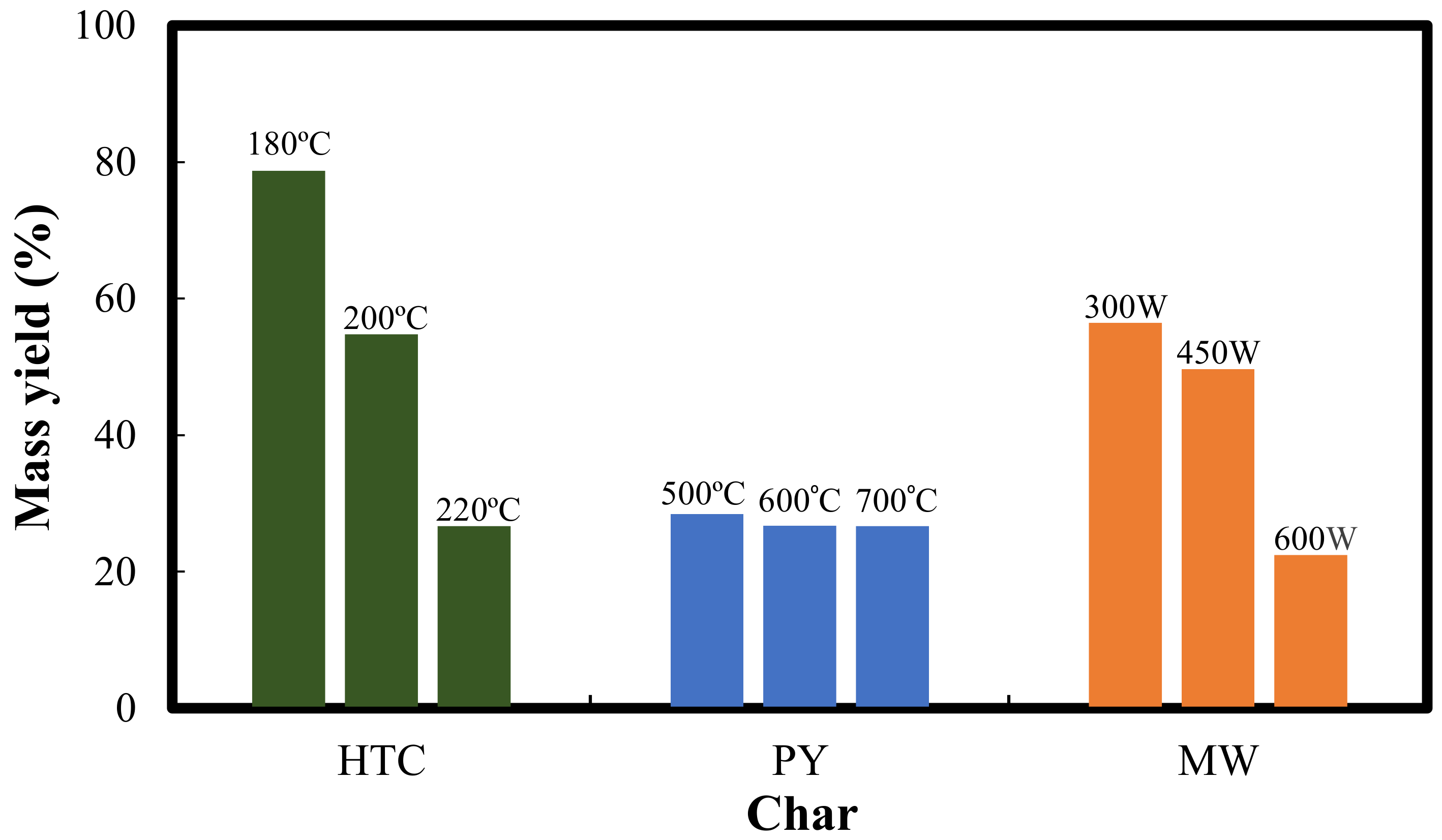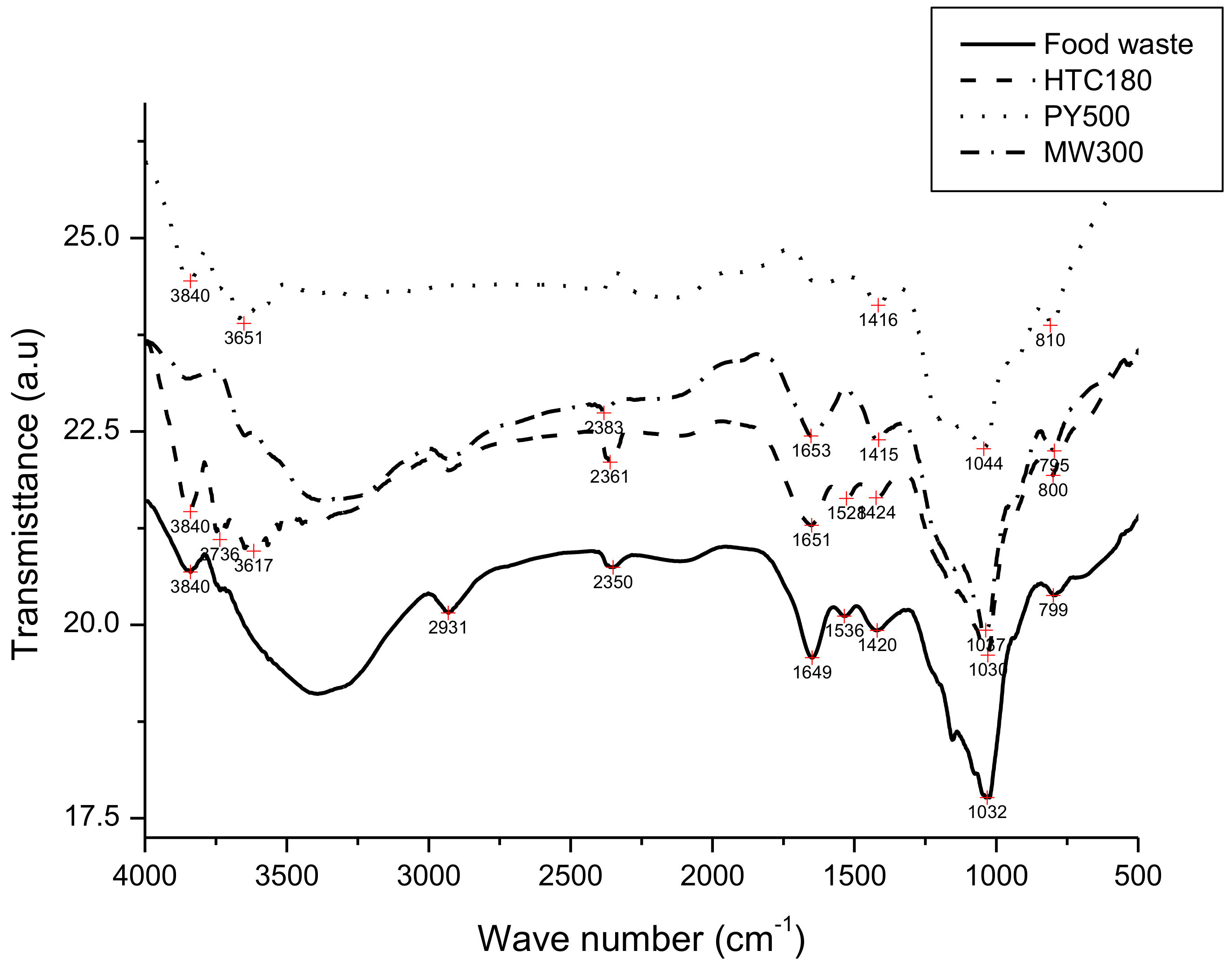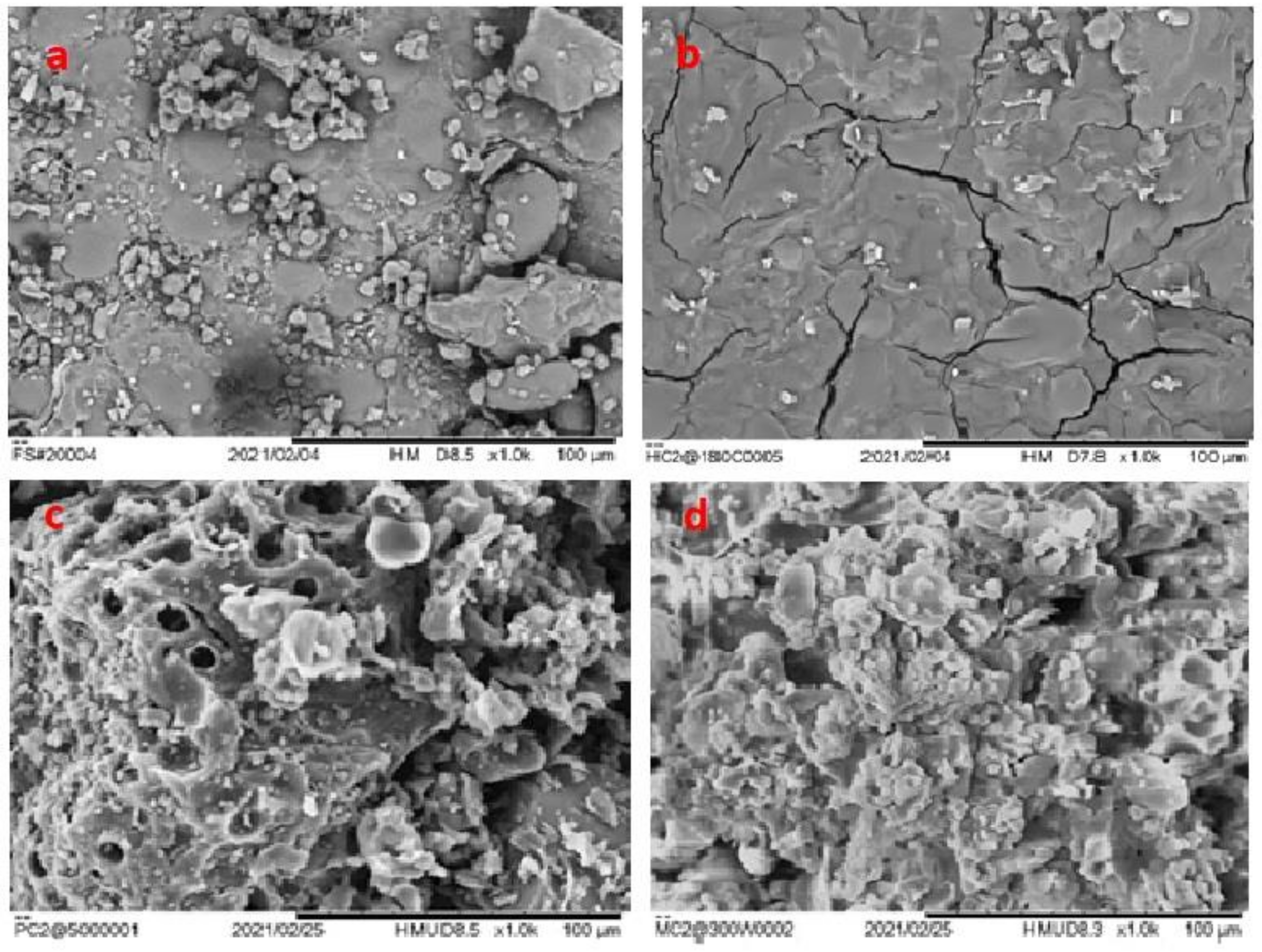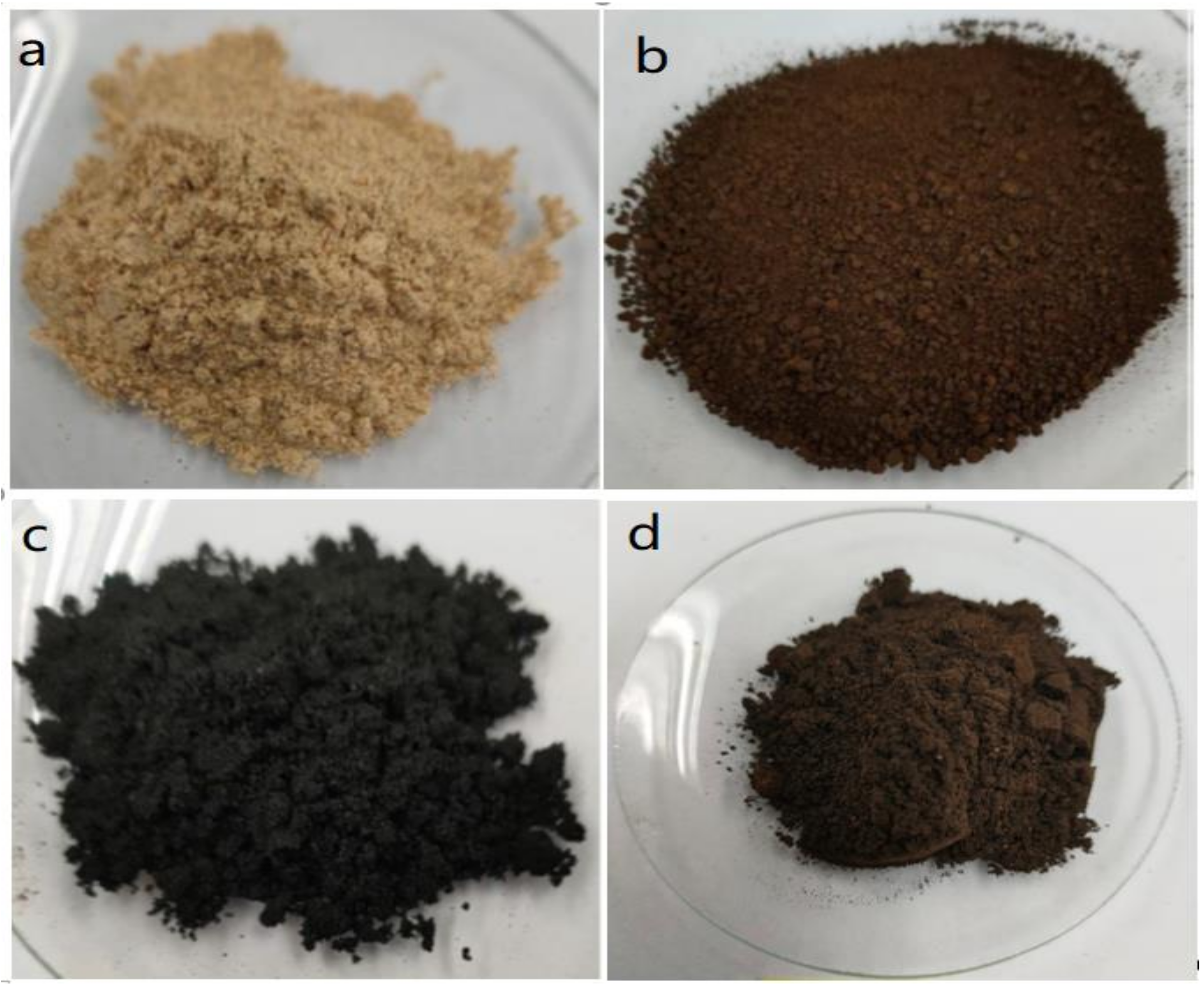Comparative Investigation of the Physicochemical Properties of Chars Produced by Hydrothermal Carbonization, Pyrolysis, and Microwave-Induced Pyrolysis of Food Waste
Abstract
:1. Introduction
2. Experimental
2.1. Preparation of Food Waste Mixture
2.2. Preparation of Char by Hydrothermal Carbonization
2.3. Preparation of Char by Conventional Pyrolysis
2.4. Preparation of Char by Microwave Induced Pyrolysis
2.5. Physical and Chemical Property Analysis of the Chars
2.5.1. Mass Yield Analysis of the Chars
2.5.2. Elemental Analysis
2.5.3. Calorific Value Analysis
2.5.4. Fourier Transform Infra-Red Analysis
2.5.5. Scanning Electron Microscopic Analysis
3. Results and Discussion
4. Conclusions
Author Contributions
Funding
Institutional Review Board Statement
Informed Consent Statement
Data Availability Statement
Acknowledgments
Conflicts of Interest
References
- Kim, S.; Lee, Y.; Lin, K.-Y.A.; Hong, E.; Kwon, E.E.; Lee, J. The valorization of food waste via pyrolysis. J. Clean. Prod. 2020, 259, 120816. [Google Scholar] [CrossRef]
- FAO. FAOSTAT. 2019. Available online: http://www.fao.org/faostat/en/#data/QC (accessed on 19 June 2021).
- Flanagan, A.; Priyadarshini, A. A study of consumer behaviour towards food-waste in Ireland: Attitudes, quantities and global warming potentials. J. Environ. Manag. 2021, 284, 112046. [Google Scholar] [CrossRef] [PubMed]
- Joshi, P.; Visvanathan, C. Sustainable management practices of food waste in Asia: Technological and policy drivers. J. Environ. Manag. 2019, 247, 538–550. [Google Scholar] [CrossRef] [PubMed]
- Lo, I.M.C.; Woon, K.S. Food waste collection and recycling for value-added products: Potential applications and challenges in Hong Kong. Environ. Sci. Pollut. Res. 2015, 23, 7081–7091. [Google Scholar] [CrossRef] [PubMed]
- Rasheed, R.; Umer, R.; Hamid, A.; Rizwan, A.; Javed, H.; Ahmad, S.R.; Su, Y. Waste valorization and resource conservation in rice processing industries—An analytical study from Pakistan. Environ. Sci. Pollut. Res. 2020, 27, 43372–43388. [Google Scholar] [CrossRef] [PubMed]
- Carmona-Cabello, M.; García, I.L.; Sáez-Bastante, J.; Pinzi, S.; Koutinas, A.A.; Dorado, M.P. Food waste from restaurant sector—Characterization for biorefinery approach. Bioresour. Technol. 2020, 301, 122779. [Google Scholar] [CrossRef]
- Melikoglu, M. Reutilisation of food wastes for generating fuels and value added products: A global review. Environ. Technol. Innov. 2020, 19, 101040. [Google Scholar] [CrossRef]
- Zhuang, X.; Liu, J.; Zhang, Q.; Wang, C.; Zhan, H.; Ma, L. A review on the utilization of industrial biowaste via hydrothermal carbonization. Renew. Sustain. Energy Rev. 2021, 154, 111877. [Google Scholar] [CrossRef]
- Khiari, B.; Massoudi, M.; Jeguirim, M. Tunisian tomato waste pyrolysis: Thermogravimetry analysis and kinetic study. Environ. Sci. Pollut. Res. 2019, 26, 35435–35444. [Google Scholar] [CrossRef]
- Lin, J.; Ma, R.; Luo, J.; Sun, S.; Cui, C.; Fang, L.; Huang, H. Microwave pyrolysis of food waste for high-quality syngas production: Positive effects of a CO2 reaction atmosphere and insights into the intrinsic reaction mechanisms. Energy Convers. Manag. 2020, 206, 112490. [Google Scholar] [CrossRef]
- Khan, M.A.; Alqadami, A.A.; Wabaidur, S.M.; Siddiqui, M.R.; Jeon, B.-H.; Alshareef, S.A.; Alothman, Z.A.; Hamedelniel, A.E. Oil industry waste based non-magnetic and magnetic hydrochar to sequester potentially toxic post-transition metal ions from water. J. Hazard. Mater. 2020, 400, 123247. [Google Scholar] [CrossRef] [PubMed]
- Zhai, Y.; Wang, T.; Zhu, Y.; Peng, C.; Wang, B.; Li, X.; Li, C.; Zeng, G. Production of fuel pellets via hydrothermal carbonization of food waste using molasses as a binder. Waste Manag. 2018, 77, 185–194. [Google Scholar] [CrossRef] [PubMed]
- Sharma, H.B.; Dubey, B.K. Co-hydrothermal carbonization of food waste with yard waste for solid biofuel production: Hydrochar characterization and its pelletization. Waste Manag. 2020, 118, 521–533. [Google Scholar] [CrossRef] [PubMed]
- Kumar, A.; Saini, K.; Bhaskar, T. Hydochar and biochar: Production, physicochemical properties and techno-economic analysis. Bioresour. Technol. 2020, 310, 123442. [Google Scholar] [CrossRef] [PubMed]
- Lv, B.-W.; Xu, H.; Guo, J.-Z.; Bai, L.-Q.; Li, B. Efficient adsorption of methylene blue on carboxylate-rich hydrochar prepared by one-step hydrothermal carbonization of bamboo and acrylic acid with ammonium persulphate. J. Hazard. Mater. 2022, 421, 126741. [Google Scholar] [CrossRef]
- Fu, M.-M.; Mo, C.-H.; Li, H.; Zhang, Y.-N.; Huang, W.-X.; Wong, M.H. Comparison of physicochemical properties of biochars and hydrochars produced from food wastes. J. Clean. Prod. 2019, 236, 117637. [Google Scholar] [CrossRef]
- Olszewski, M.P.; Nicolae, S.A.; Arauzo, P.J.; Titirici, M.-M.; Kruse, A. Wet and dry? Influence of hydrothermal carbonization on the pyrolysis of spent grains. J. Clean. Prod. 2020, 260, 121101. [Google Scholar] [CrossRef]
- Theppitak, S.; Hungwe, D.; Ding, L.; Xin, D.; Yu, G.; Yoshikawa, K. Comparison on solid biofuel production from wet and dry carbonization processes of food wastes. Appl. Energy 2020, 272, 115264. [Google Scholar] [CrossRef]
- Wei, J.; Guo, Q.; Song, X.; Ding, L.; Mosqueda, A.; Liu, Y.; Yoshikawa, K.; Yu, G. Effect of hydrothermal carbonization temperature on reactivity and synergy of co-gasification of biomass hydrochar and coal. Appl. Therm. Eng. 2021, 183, 116232. [Google Scholar] [CrossRef]
- Liu, H.; Ma, X.; Li, L.; Hu, Z.; Guo, P.; Jiang, Y. The catalytic pyrolysis of food waste by microwave heating. Bioresour. Technol. 2014, 166, 45–50. [Google Scholar] [CrossRef]
- Chung, H.-J.; Liu, Q.; Hoover, R. Effect of single and dual hydrothermal treatments on the crystalline structure, thermal properties, and nutritional fractions of pea, lentil, and navy bean starches. Food Res. Int. 2010, 43, 501–508. [Google Scholar] [CrossRef]
- Hu, X.; Gholizadeh, M. Biomass pyrolysis: A review of the process development and challenges from initial researches up to the commercialisation stage. J. Energy Chem. 2019, 39, 109–143. [Google Scholar] [CrossRef] [Green Version]
- El-Dalatony, M.M.; Saha, S.; Govindwar, S.P.; Abou-Shanab, R.A.; Jeon, B.-H. Biological Conversion of Amino Acids to Higher Alcohols. Trends Biotechnol. 2019, 37, 855–869. [Google Scholar] [CrossRef] [PubMed]
- Leng, L.; Yang, L.; Leng, S.; Zhang, W.; Zhou, Y.; Peng, H.; Li, H.; Hu, Y.; Jiang, S.; Li, H. A review on nitrogen transformation in hydrochar during hydrothermal carbonization of biomass containing nitrogen. Sci. Total Environ. 2021, 756, 143679. [Google Scholar] [CrossRef] [PubMed]
- Zhang, J.; Tian, Y.; Cui, Y.; Zuo, W.; Tan, T. Key intermediates in nitrogen transformation during microwave pyrolysis of sewage sludge: A protein model compound study. Bioresour. Technol. 2013, 132, 57–63. [Google Scholar] [CrossRef]
- Su, H.; Zhou, X.; Zheng, R.; Zhou, Z.; Zhang, Y.; Zhu, G.; Yu, C.; Hantoko, D.; Yan, M. Hydrothermal carbonization of food waste after oil extraction pre-treatment: Study on hydrochar fuel characteristics, combustion behavior, and removal behavior of sodium and potassium. Sci. Total Environ. 2021, 754, 142192. [Google Scholar] [CrossRef]
- Pariyar, P.; Kumari, K.; Jain, M.K.; Jadhao, P.S. Evaluation of change in biochar properties derived from different feedstock and pyrolysis temperature for environmental and agricultural application. Sci. Total Environ. 2020, 713, 136433. [Google Scholar] [CrossRef]
- Zheng, N.-Y.; Lee, M.; Lin, Y.-L.; Samannan, B. Microwave-assisted wet co-torrefaction of food sludge and lignocellulose biowaste for biochar production and nutrient recovery. Process Saf. Environ. Prot. 2020, 144, 273–283. [Google Scholar] [CrossRef]
- Richards, A.P.; Haycock, D.; Frandsen, J.; Fletcher, T.H. A review of coal heating value correlations with application to coal char, tar, and other fuels. Fuel 2021, 283, 118942. [Google Scholar] [CrossRef]
- Bagade, R.; Gomaji, R. Microspheres/Custard-Apples Copper (II) Chelate Polymer: Characterization, Docking, Antioxidant and Antibacterial Assay. ChemistrySelect 2019, 4, 6233–6244. [Google Scholar] [CrossRef]
- Correa, C.R.; Hehr, T.; Voglhuber-Slavinsky, A.; Rauscher, Y.; Kruse, A. Pyrolysis vs. hydrothermal carbonization: Understanding the effect of biomass structural components and inorganic compounds on the char properties. J. Anal. Appl. Pyrolysis 2019, 140, 137–147. [Google Scholar] [CrossRef]




| Parameter | Food Wastes | HTC180 | PY500 | MW300 |
|---|---|---|---|---|
| Elemental Analyses | ||||
| C (%) | 41.44 | 48.23 | 72.73 | 54.02 |
| H (%) | 4.75 | 5.21 | 0.94 | 3.98 |
| N (%) | 3.89 | 4.01 | 3.94 | 3.84 |
| S (%) | 0.54 | 0.74 | 0.14 | 0.46 |
| O (%) | 49.38 | 41.81 | 22.25 | 37.70 |
| O/C | 1.19 | 0.87 | 0.31 | 0.70 |
| H/C | 0.11 | 0.11 | 0.01 | 0.07 |
| Calorific Value | ||||
| HHV (kcal/kg) | 3851.00 | 4517.00 | 5864.00 | 5023.00 |
| LHV (kcal/kg) | 3751.00 | 4459.00 | 5769.00 | 4952.00 |
| Ash content (%) | 4.07 | 6.19 | 6.27 | 7.45 |
Publisher’s Note: MDPI stays neutral with regard to jurisdictional claims in published maps and institutional affiliations. |
© 2022 by the authors. Licensee MDPI, Basel, Switzerland. This article is an open access article distributed under the terms and conditions of the Creative Commons Attribution (CC BY) license (https://creativecommons.org/licenses/by/4.0/).
Share and Cite
Khan, M.A.; Hameed, B.H.; Siddiqui, M.R.; Alothman, Z.A.; Alsohaimi, I.H. Comparative Investigation of the Physicochemical Properties of Chars Produced by Hydrothermal Carbonization, Pyrolysis, and Microwave-Induced Pyrolysis of Food Waste. Polymers 2022, 14, 821. https://doi.org/10.3390/polym14040821
Khan MA, Hameed BH, Siddiqui MR, Alothman ZA, Alsohaimi IH. Comparative Investigation of the Physicochemical Properties of Chars Produced by Hydrothermal Carbonization, Pyrolysis, and Microwave-Induced Pyrolysis of Food Waste. Polymers. 2022; 14(4):821. https://doi.org/10.3390/polym14040821
Chicago/Turabian StyleKhan, Moonis Ali, Bassim H. Hameed, Masoom Raza Siddiqui, Zeid A. Alothman, and Ibrahim H. Alsohaimi. 2022. "Comparative Investigation of the Physicochemical Properties of Chars Produced by Hydrothermal Carbonization, Pyrolysis, and Microwave-Induced Pyrolysis of Food Waste" Polymers 14, no. 4: 821. https://doi.org/10.3390/polym14040821
APA StyleKhan, M. A., Hameed, B. H., Siddiqui, M. R., Alothman, Z. A., & Alsohaimi, I. H. (2022). Comparative Investigation of the Physicochemical Properties of Chars Produced by Hydrothermal Carbonization, Pyrolysis, and Microwave-Induced Pyrolysis of Food Waste. Polymers, 14(4), 821. https://doi.org/10.3390/polym14040821










